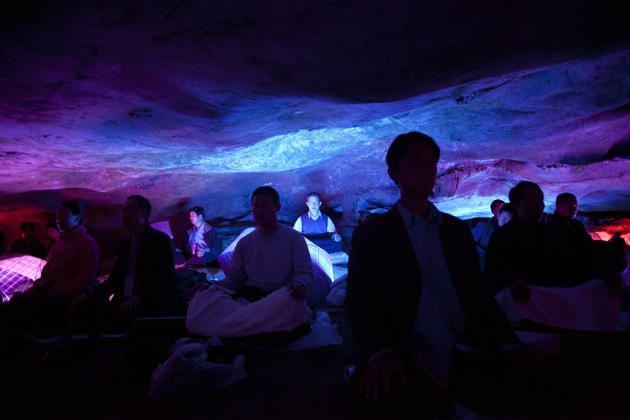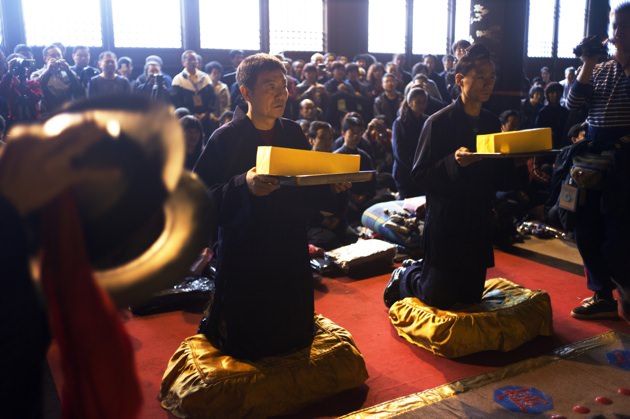Lift up your head
Calm your eyes
Look far away, as far as you can
Look beyond the walls
What do you see?
The Jinhua caves are located in a wooded, hilly area about 200 miles southwest of Shanghai. The most famous cave, Double Dragon Cave, is entered by a stream that passes under a stone overhang just a few inches above the water. Visitors must lie flat in a shallow boat as it is pulled by wires under the outcrop. Rock whizzes by a couple of inches in front of your face and suddenly you are there, in the earth’s womb, where people have come for millennia to meditate—lifting up their heads, calming their eyes, and visualizing a world beyond the walls that hold us.
In November, I came to Jinhua with about 400 others on a ten-day retreat to study with Wang Liping, probably China’s most famous teacher of qigong, a form of meditation and breathing exercises rooted in traditional Chinese religion. Qigong’s heyday was in the 1980s and 1990s, when it spread rapidly across China as a kind of ersatz religion. Back then, the Communist Party still actively discouraged religious life but qigong escaped regulation because its backers had cleverly registered it as a sport. In fact, it offered a typically Chinese path to salvation: physical cultivation leading to enlightenment. Some qigong “grand masters” claimed supernatural abilities, saying they could conduct electricity or read books without opening them. But many offered moral guidelines—”popular fundamentalism,” some scholars called it—that appealed to people who had seen the Communists’ ideals collapse during the Cultural Revolution.
This was the beginning of China’s religious revival and qigong became ubiquitous in Chinese parks and streets. Chinese spoke of a “qigong fever” that had infected the country. But it came to a crashing close in 1999 when the government brutally cracked down on the militant qigong group Falun Gong after it staged protests in downtown Beijing. Most qigong groups disappeared or went underground, and as a result it is all but impossible today to practice qigong in public parks.
Wang, who stopped teaching before the crackdown and laid low for much of the past decade, avoided this maelstrom. Now he is making a comeback. Among the qigong masters, he had always been somewhat unusual in emphasizing the religious roots of his teaching—specifically, in China’s only indigenous religion, Daoism. Back in the 1980s and 1990s, government officials widely saw Daoism as the most backward religion— practices like palm reading or fengshui were routinely condemned as “feudal superstition.” But faced with the rising popularity of foreign religions, especially Christianity, the government is beginning to endorse Daoism, too. Though he remains cautious, Wang has quietly begun teaching again in public, shunning the word “qigong” in favor of the Daoist term “inner alchemy.”
The 62-year-old Wang has had a colorful career, even if one isn’t sure how literally to take his official biography. According to that account, in the 1950s he was chosen by three Daoist masters of the Longmen (Dragon Gate) school to be their successor—the 18th generation in a lineage. He lived at home on the outskirts of the northeastern Chinese city of Fushun but after school would meet his teachers in the forest for intense training; they would sometimes bind him cross-legged so he would stop fidgeting.
When Maoists launched the Cultural Revolution in 1966, the four of them took to the mountains and lived there for over a decade, practicing esoteric Daoist self-cultivation practices, studying plant life and helping villagers suffering from calamities. While Red Guards roamed the valleys, destroying temples and schools, they traveled the mountains, avoiding most people until stability returned to China with the Maoists’ ouster in the late 1970s.
In the 1980s and 1990s, Wang’s classes were hugely popular, some resembling revival-style rallies in auditoriums and gymnasiums across the country. Nowadays, he doesn’t advertise openly and there are no public rallies, but hundreds show up to his once- or twice- a year retreats for the chance to learn from the master. The high point is the autumn Jinhua classes, which took place this year near the caves, in the Temple to the Immortal Huang, a historic deity who achieved immortality in the 4th century by meditating here. Over the past few decades, ethnic Chinese donors have helped rebuild the temple in a grand manner, with a reflecting pool and four courtyards leading to the main hall, a soaring building of 9,000 square feet and 50-foot ceilings.
Standing in front of the immense statue to Huang, Wang delivered two hour-long lectures each day followed by an hour and a half to two hours of meditation. Every evening, one of his acolytes would hold a class to help out newcomers. A 400-page textbook helped fill in the gaps.
Advertisement
Wang’s own teachings hew close to the Daoist practices described in such classic books like the lingbao bifa (Complete Methods of the Numinous Treasure) and the taiyi jinhua zongzhi (The Secret of the Golden Flower) which—translated by the German sinologist Richard Wilhelm in 1929—is one of the few Daoist cultivation books widely known in the West, thanks in part to an introduction written by Wilhelm’s friend, the Swiss psychiatrist Carl Jung. (For early 20th-century Europeans, the practices seemed like another route to the subconscious.) Unlike his teachers, Wang feels that these books should be taught using modern methods: he shuns binding children and—in a sharp break from Daoist tradition—openly teaches some of the once-secret methods.
As the only non-ethnic Chinese in the group, I was quickly adopted as the class mascot. People congratulated me on understanding the value of traditional Chinese cultivation practices, though meditating wasn’t quite like I imagined. For one thing it is more painful. The body’s legs are supposed to form a stable platform. The goal is to call up one’s soul, the shenguang. It manifests itself as a light, which is brought into the body and used to purify the five organs—liver, lungs, heart, spleen and kidneys—which correspond to the five elements of Chinese cosmology. But even simply sitting cross-legged, I found my legs going numb after 45 minutes, then aching. Eventually, I was in such pain that I couldn’t concentrate on the meditation and began to fantasize about ways of escaping.
All the while, one is regulating one’s breathing. It is the most basic voluntary movement we make; controlling it is the basis of controlling oneself. Although we breath through our lungs, the goal in Daoist meditation is to breathe with all of one’s body, expanding and contracting every pore. At the retreat, we also learned more active practices, such as brisk walking. For an hour after breakfast each day we marched through the mountain roads, the pace matched to breathing, you walk either three, six, or twelve paces per inhalation and the same number per exhalation.
The best days were when we meditated in the Jinhua caves. My favorite wasn’t the Double Dragon Cave, or Shuanglongdong, which is a major tourist site and couldn’t be closed for our visits. But the Chaozhendong, or “Cave for Worshipping the Perfected Man” was more off the beaten track. The Daoist nun who managed it would turn off the lights when we were inside. Soon, all one could hear were the bats flying around and the drip of water seeping in from outside. Some practitioners cried out and one woman started sobbing. Wang said we shouldn’t be surprised. “We Chinese aren’t very introspective,” he told the class before going to the cave. “You think of things, like your father or your mother. It’s okay.”
As I got to know members of our group, I began to realize how many unusual people were in our midst. One man with incredibly strong thighs and buttocks would walk around the retreat in a squat, as if out of the Ministry of Silly Walks. One person nodded sagely and said: “That man has talent.” Then there was the man who wore pink-striped pajamas the entire time, and the woman who could sit in the lotus position for eight hours. My favorite eccentric was a 76-year-old woman who said she had a vision in 1986 that Wang had revealed himself to be a Daoist master. She contacted Wang and invited him to Jinhua to teach, the first of his many visits here. She also quietly distributed pictures of Wang with something that looked like an overexposed strip above his head. “That is his dragon spirit revealing itself,” she said. “It can’t be photographed.”
At times, Wang seemed less a dragon spirit than a bumbling professor. He would get his microphone cables mixed up and often mumbled odd offhand advice, such as what kind of dumplings to eat in the winter (answer: mutton). But his followers have stuck with him for decades and seemed genuinely excited about the event. I met one student who paid her way from the remote province of Guizhou because she was desperate to know about Daoist physical cultivation—a key to Daoism is bodily practice, not just praying or moral behavior and she wanted to see it first hand. Another man lived as a hermit near the Yangtze and had been planning to attend one of Wang’s retreats for over a decade. He finally left his cave this year and took part.
Advertisement
Today, the importance of classes like Wang’s is underscored by the rapid disappearance of knowledge about the physical cultivation practices he teaches and that once held sway. One of Wang’s long-time students, Shen Zhigang, said that for him, studying with Wang was a way of reconnecting to traditional Chinese values. “We’re studying Teacher Wang but he has predecessors who go back and back and back to Laozi,” he said, referring to the mythic author of Daoism’s key text, the Daodejing. “The thread still hasn’t been cut. It was almost cut. This is why we’re studying this. We have to keep the thread intact and pass it down to the next generations.”
After over 30 hours of meditation, I couldn’t get out of my head the liturgy we’d hear during the sessions. It was said in a rhythmic, calm voice, urging us to push beyond the perceived world. In a country that has discovered materialism, it was a reminder that other forces haven’t disappeared.
Inhale, pull the room into you
Exhale, push out the walls of this room
Inhale, contract the room
Exhale, expand it
Inhale
Exhale
Now you are entering a half-sleep state of consciousness
Clear your mind




